
Whether you’re starting out from scratch or growing your existing brand’s organic search presence, there’s nothing stopping you from disrupting the search results pages of your industry one step at a time.
The key to doing this is keyword selection.
Combine this with killer, shareable content and a solid link building strategy, and you’re well on your way to boosting your organic traffic.
In this case study, you’ll learn exactly how my team at The Search Initiative increased our client’s organic traffic by 368% and monthly revenue by 445% despite their industry being dominated by a big competitor.


In this article, you’ll learn how to:
Before that, here’s some more information about the website’s goals and the main challenges that we overcame during the campaign.
The Challenge
The client produces and sells nicotine alternatives that use natural ingredients instead of tobacco. The brand and product had close-to zero online presence when joining the agency and their main competitor had already monopolized the market – so the main objective for the campaign was to build organic traffic from the ground up and generate online sales through eCommerce.
One of the main challenges was the fact that keywords that had any substantial search volume were extremely competitive and dominated by their main competitor. As a start-up, the client’s site lacked the topical and domain authority required to be able to compete for such terms.

Instead, we focused on building visibility by targeting informational search queries about quitting smoking such as smoking alternatives.
By focusing on producing more content on the blog, we needed to make sure that the client’s products were showcased in the articles so that users were enticed to click through and place an order.
This was achieved by implementing a related posts section (designed to keep users longer on the site), a sidebar (so that we could add calls to actions) and adding internal links (to drive users towards relevant product pages).
To build the brand’s online presence, we focused our link building efforts through digital PR, so that people would start to know that the brand and product range existed.
Finally, we rounded off the strategy by making sure that any technical issues holding back the site’s performance were addressed.
The two main issues that we tackled was to implement a more user-friendly URL structure (so that they were easy to read, remember and share for users) and to improve the page performance (by compressing and minifying files that were large).
Find out how you can overcome these challenges for your website by following the steps below.
Informational Keyword Targeting
With the commercial keywords out of bounds due to high competition and lack of topical authority, we focused on building the site’s keyword visibility for informational search terms instead by producing content around question-based keywords related to smoking.
How to Find Question Based Keywords to Target
I’ll show you two ways to find question-based keywords that are relevant to your site’s niche.
Ahrefs Keywords Explorer
The first is using Ahrefs’ Keywords Explorer tool.
 Enter a broad seed keyword that’s relevant to your website and make sure to select the correct country that you want to target. For example, “cats”.
Enter a broad seed keyword that’s relevant to your website and make sure to select the correct country that you want to target. For example, “cats”.
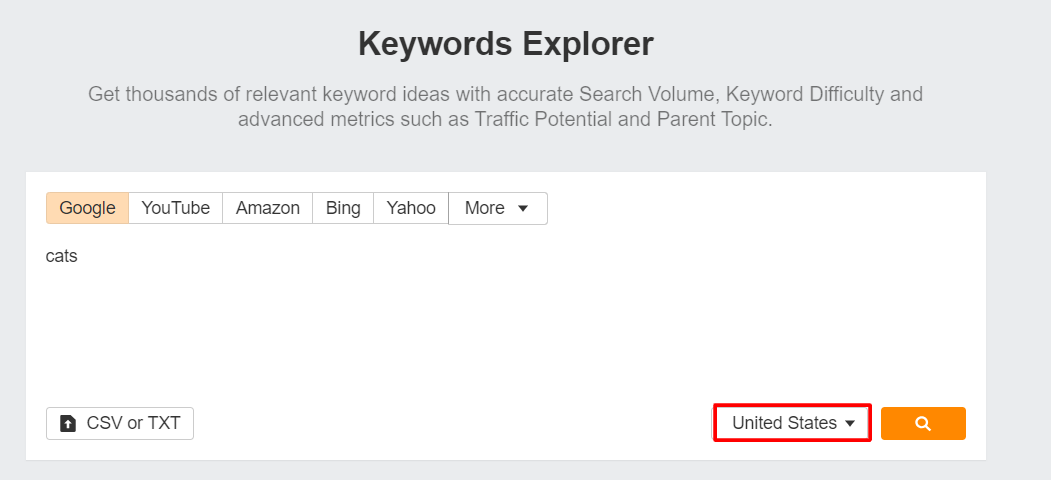
 Scroll down to the Keyword ideas section and click on the View all under the Questions block.
Scroll down to the Keyword ideas section and click on the View all under the Questions block.

 Filter the results so that the keywords are grouped by Parent Topic. This’ll help **** together all of the terms that are similar and make it easier to form your content plan.
Filter the results so that the keywords are grouped by Parent Topic. This’ll help **** together all of the terms that are similar and make it easier to form your content plan.

 The report shows all keywords that are phrased as questions.
The report shows all keywords that are phrased as questions.
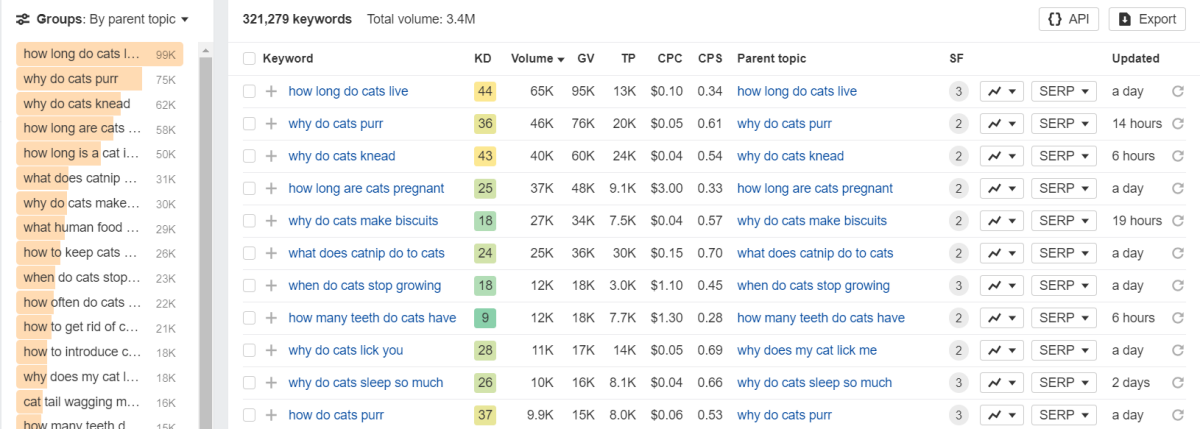
 Clicking on one of the Parent topics will show you all of the informational keywords that are relevant for that topic. For example, there are 130 keywords with a combined search volume of 100K in the U.S. related to “how long do cats live”.
Clicking on one of the Parent topics will show you all of the informational keywords that are relevant for that topic. For example, there are 130 keywords with a combined search volume of 100K in the U.S. related to “how long do cats live”.

You can now go ahead and write an article about the lifespan of cats.
People Also Ask
If you don’t have Ahrefs, you can still find informational keywords from the People Also Ask section in Google’s search results.
 Enter a seed keyword that’s relevant to your niche and scroll down to the People Also Ask section.
Enter a seed keyword that’s relevant to your niche and scroll down to the People Also Ask section.
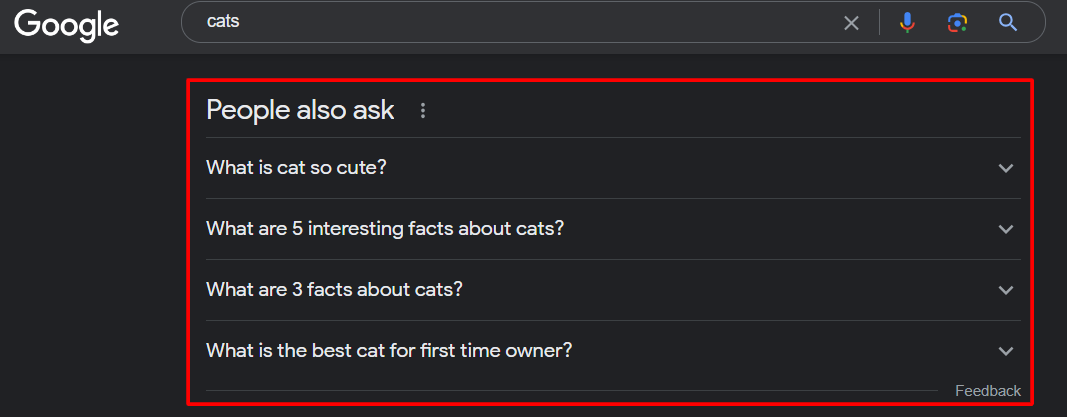
 Expanding one of these questions will open up the top ranking result as well as unveil more related questions.
Expanding one of these questions will open up the top ranking result as well as unveil more related questions.

In the above example, Google added the two following questions “What is the friendliest cat to own?” and “What is the kindest type of cat?” when expanding the original question “What is the best cat for first time owner?”.
 You can repeat the process and go deeper into the rabbit hole to find even more related questions . Before you know it, you have a blueprint of what kind of information you need to include to satisfy users who are looking to give their first cat a home!
You can repeat the process and go deeper into the rabbit hole to find even more related questions . Before you know it, you have a blueprint of what kind of information you need to include to satisfy users who are looking to give their first cat a home!
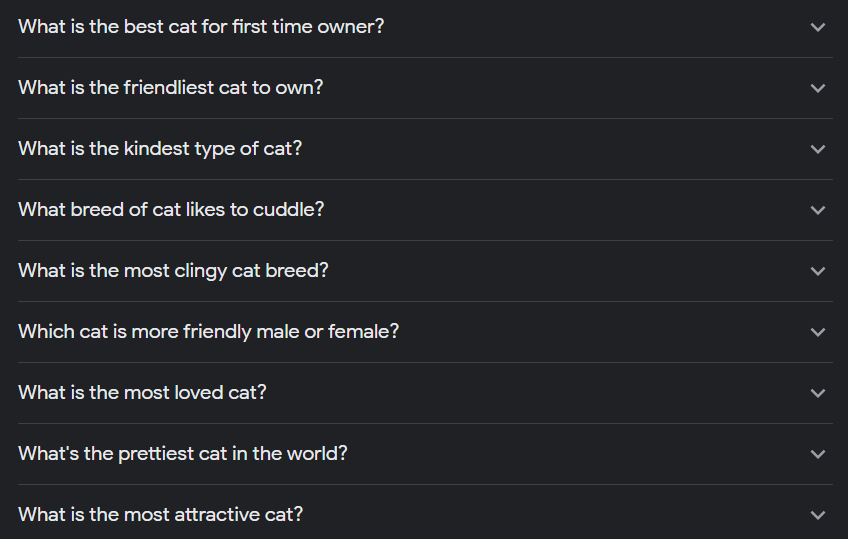
 The best part about using this method is that Google provides the page that it feels best answers this question – so you can use the competing page as a baseline for your own page.
The best part about using this method is that Google provides the page that it feels best answers this question – so you can use the competing page as a baseline for your own page.
Writing Content for Informational Search Terms
Once you’ve found the informational keywords that you want to target, the next step is to start writing the content.
Here are some tips on how you should do this:
 Do Your Research, Competitor Research – perform a Google search of your target keyword (for example “how long do cats live”) and analyze the top ranking competing pages to see what their content is like.
Do Your Research, Competitor Research – perform a Google search of your target keyword (for example “how long do cats live”) and analyze the top ranking competing pages to see what their content is like.
Here’s what you need to look for:
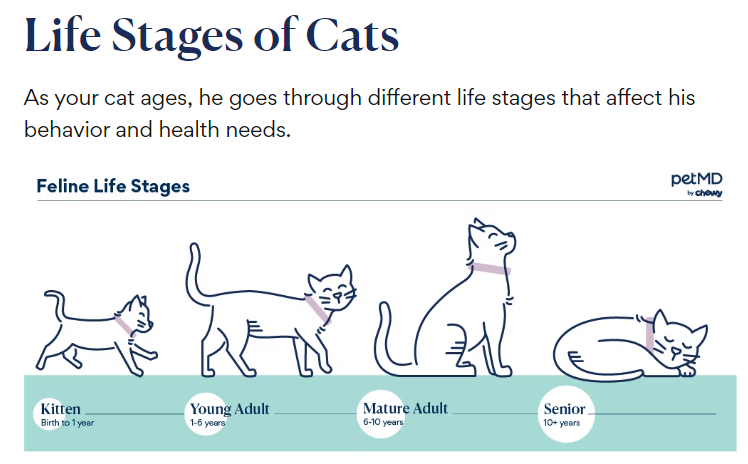
Use your competitors as a baseline for what you need to include within your page. You should also look at how they have optimized other on-page elements such as the title tag, H1 heading, meta description and their URL for the target keyword.
 Answer Questions As Clearly As Possible – when it comes to actually writing the answers to questions, it’s good practice to be as clear and concise as possible. Doing so increases your chances of appearing within the featured snippet result for that keyword.
Answer Questions As Clearly As Possible – when it comes to actually writing the answers to questions, it’s good practice to be as clear and concise as possible. Doing so increases your chances of appearing within the featured snippet result for that keyword.
For example, here’s the featured snippet for the keyword “how long do cats live”.
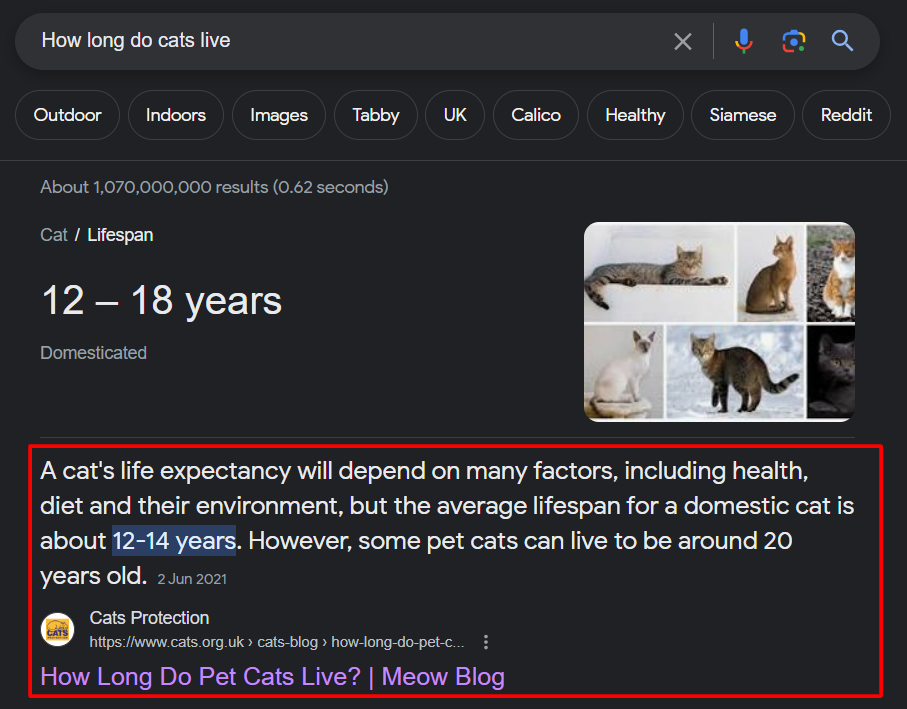
And here’s where the answer is taken from within the ranking page.

As you can see, the page provides a clear and concise answer to the question right at the beginning of the article. Then it goes into much more detail about the lifespan of cats later on in the article by covering more specific topics like which type of cats live the longest etc.
The short answer caters to users who just want an instant answer to their search query whereas the rest of the article is for users who want to learn more.
 Demonstrate Your Expertise – Google (and readers) want to ensure that the information provided in the search results is from credible, trustworthy sources.
Demonstrate Your Expertise – Google (and readers) want to ensure that the information provided in the search results is from credible, trustworthy sources.
This is especially important if you’re writing about a topic that can impact a user’s physical, mental or financial well being. But even websites that don’t fall into this category need to demonstrate their expertise in order to build trust.
Here are a few ways you can achieve this:

 Add Internal Links – internal linking helps guide users towards your core pages; the ones where you want your users to perform some sort of conversion. In our client’s case (an eCommerce website), we added internal links to relevant product and category pages.
Add Internal Links – internal linking helps guide users towards your core pages; the ones where you want your users to perform some sort of conversion. In our client’s case (an eCommerce website), we added internal links to relevant product and category pages.
Following the above steps will help grow your keyword visibility for informational search terms.
Redesigning The Blog for SEO
Apart from optimizing and expanding the content on your blog, it’s also important to ensure you’re following best practices in making it as functional as possible for users.
Below are things that you should include within your blog to improve navigation and overall usability.
Add Related Posts
A Related Posts section provides readers with additional relevant content that they might be interested in.

It helps users discover more of your blog’s content, increasing their engagement and time spent on your website.
In addition to this, related posts help:
How Should I Choose Related Posts?
When selecting the related articles, make sure that they are indeed relevant to the current post so that readers are naturally encouraged to continue reading.
Where Should the Related Posts Be Added?
The most common place to put your related posts section is towards the bottom of the page.
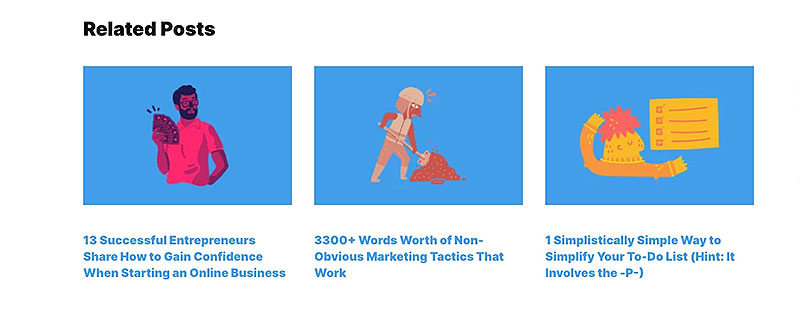
How Many Related Posts Should I Include?
When it comes to how many related posts to include, I recommend aiming for 3 to 5. Adding too many will confuse readers as to what to read next and dilute the importance of each related article.
How Can I Add Related Posts?
One of the most popular WordPress plugins for related posts is the Contextual Related Posts plugin. It’s a free plugin that automatically generates a list of related posts based on contextual cues from your blog post’s title and content. All you have to do is install and activate the plugin.

If you’re looking for something that allows for more customization, check out the Custom Related Posts plugin which allows you to pick your related posts manually.
The purpose of most blog posts is to provide information, not to sell. However, that doesn’t mean that you can convert users looking for information to customers.
One way to do this is to leverage the space in your sidebar by adding calls to action (CTAs) and other enticing content.
Here are some examples of what you can add to boost engagement and conversions:
 Sign Up Forms: adding a small form asking the visitor to leave their name and email address so that they can subscribe to your newsletter.
Sign Up Forms: adding a small form asking the visitor to leave their name and email address so that they can subscribe to your newsletter.
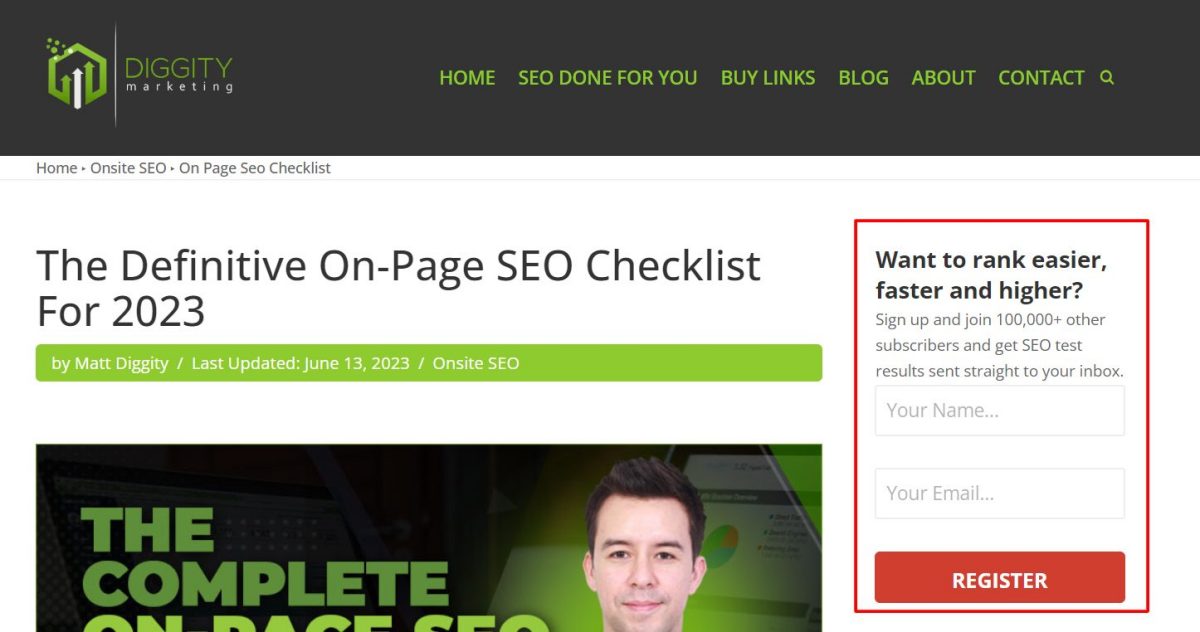
 Downloads: the sidebar is a great place to offer any downloadable assets to your users in exchange for their name and email address.
Downloads: the sidebar is a great place to offer any downloadable assets to your users in exchange for their name and email address.
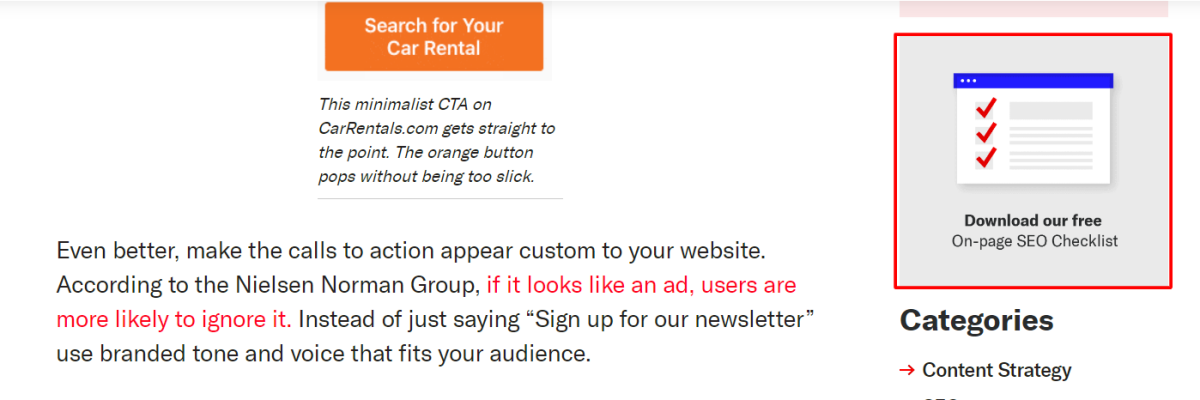
 Testimonials / Reviews: showcase your brand’s expertise and establish more trust by including reviews and testimonials from your audience.
Testimonials / Reviews: showcase your brand’s expertise and establish more trust by including reviews and testimonials from your audience.
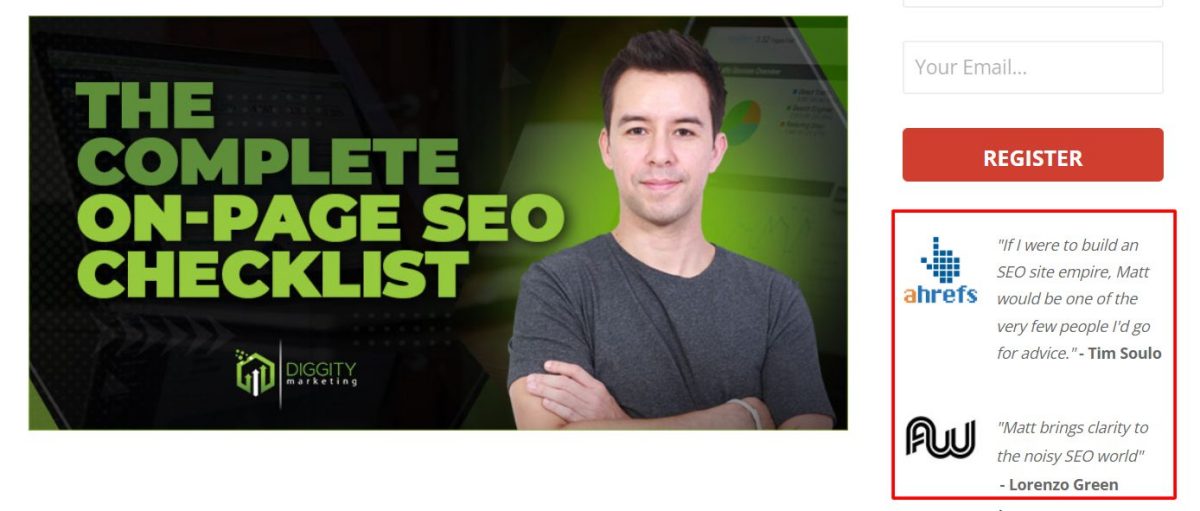
 Contact Button: add a button to make it easier for users to reach you via a call or email.
Contact Button: add a button to make it easier for users to reach you via a call or email.
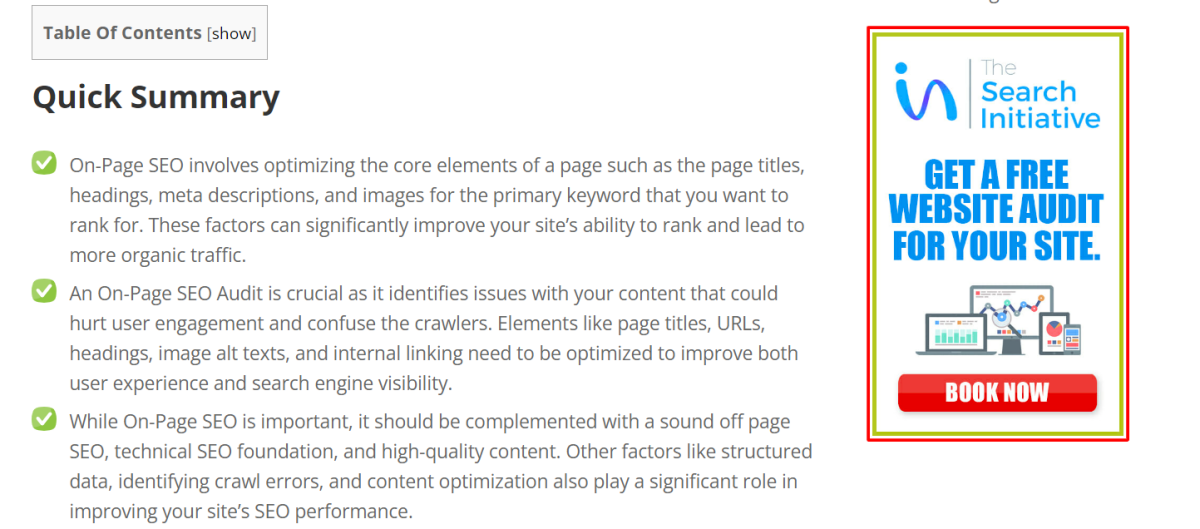
 Social Share Buttons: although some websites add share buttons to the top or bottom of their blog posts, it’s also worthwhile considering adding them in the sidebar so that they’re always visible to your users.
Social Share Buttons: although some websites add share buttons to the top or bottom of their blog posts, it’s also worthwhile considering adding them in the sidebar so that they’re always visible to your users.

 Search Bar: adding a search bar can help drive engagement as users can look for topics that are of interest to them – in turn, they stay on your website for longer.
Search Bar: adding a search bar can help drive engagement as users can look for topics that are of interest to them – in turn, they stay on your website for longer.

Building out your sidebar by adding these elements can transform the engagement levels on your website.
Add Internal Links
You’ve already learned about internal links in the form of Related Posts, but let’s focus on internal linking in its most traditional form.
The idea of internal linking is to add a hyperlink on one page on your website to another page.
These links help establish connections between different pages, improve website navigation, and assist search engines in understanding the structure and hierarchy of your website’s content.

Here are some tips on how to implement internal linking on your blog:
- Use Relevant Anchors: use descriptive anchor text (the clickable part of the link) that accurately reflects the linked page’s content. If possible, try to use anchor texts that include the main keyword that you’re trying to rank on the linked page.
- Strategic Placement: incorporate internal links so that they fit naturally within the body of your content.
- Link to Relevant Pages: distribute your internal links across relevant pages to ensure a well-connected website structure.
- Don’t Overdo It: avoid excessive internal linking on a single page, which can confuse users and dilute SEO value.
- Link Back to Your Blog Post: don’t forget to also add internal links back to your blog post too so that it too can benefit from other pages’ authority.
Building Brand Awareness With Digital PR
Considering that the client’s brand had no online presence and the product range itself had zero search volume, the site needed a boost in domain authority. The best way to do this is with backlinks.
Instead of general blogger outreach, we showcased the client’s product range with content that highlights smoking alternatives, targeted towards people looking to quit smoking and built awareness of their brand through Digital PR.
What Are PR Links?
In Digital PR (or PR link building), the focus is on building relationships with journalists, bloggers, influencers, and other media outlets to generate interest in your website or brand. This differs from traditional PR tactics which targets more conventional media outlets like TV, newspapers, magazines, etc.
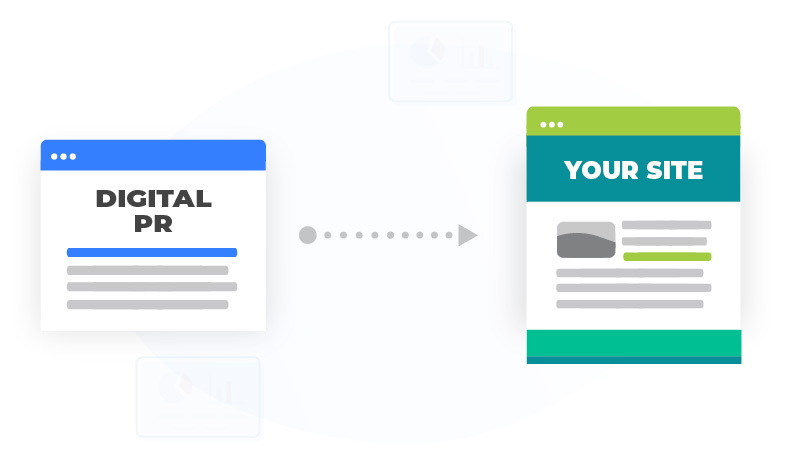
By creating compelling stories, press releases, guest articles, or participating in interviews, you can increase your chances of gaining media coverage and valuable backlinks.
Why Are They Important?
Apart from helping to grow your online presence, the benefits of PR link building include increased brand visibility, referral traffic, and credibility.
When reputable websites link to your content, it signals to search engines that your website is trustworthy and relevant, which helps boost your organic search rankings.
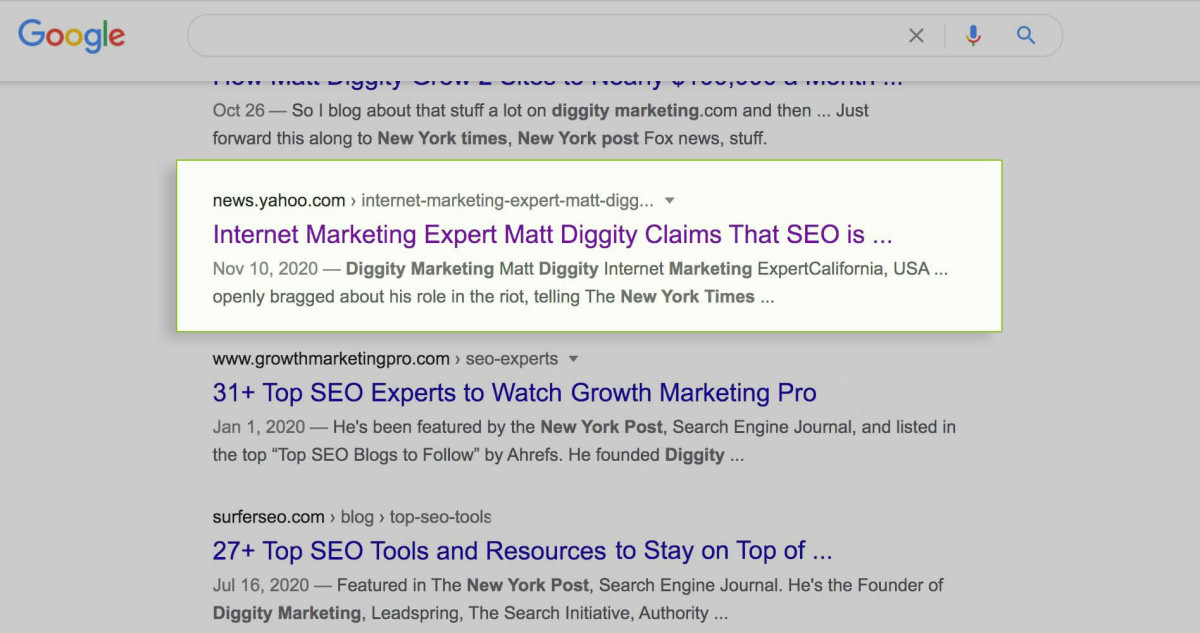
These are referred to as seed sites: which are a set of manually curated sites that Google deems to be the best on the internet. So, a link from one of these domains is super powerful and as of now, the best way to get links from sites like these (or the sites that they’ve linked to), is through Digital PR.
Digital PR also helps you establish long-standing relationships and build a network with journalists and editors within your industry. You can leverage this network to promote your brand over a long period of time.
Tips on How to Build PR Links
 Identify Your Target Audience: knowing which publications and journalists you need to target is the first step in maximizing the success of your digital PR campaign. To help you do this, think about:
Identify Your Target Audience: knowing which publications and journalists you need to target is the first step in maximizing the success of your digital PR campaign. To help you do this, think about:
Answering these kinds of questions is key to understanding your audience’s online activity and finding the best means to getting your brand in front of them.
 Research Is Key: Look for authoritative websites, blogs, media outlets, and industry-specific publications (this also includes podcasts and social media influencers) that are relevant to your niche or industry. These are the platforms you want to target for link building opportunities.
Research Is Key: Look for authoritative websites, blogs, media outlets, and industry-specific publications (this also includes podcasts and social media influencers) that are relevant to your niche or industry. These are the platforms you want to target for link building opportunities.
A great tool that you can use to do this is Prowly.
It allows you to search for journalists from a range of media outlets based on their location (country and city), contact language, topic and media type.
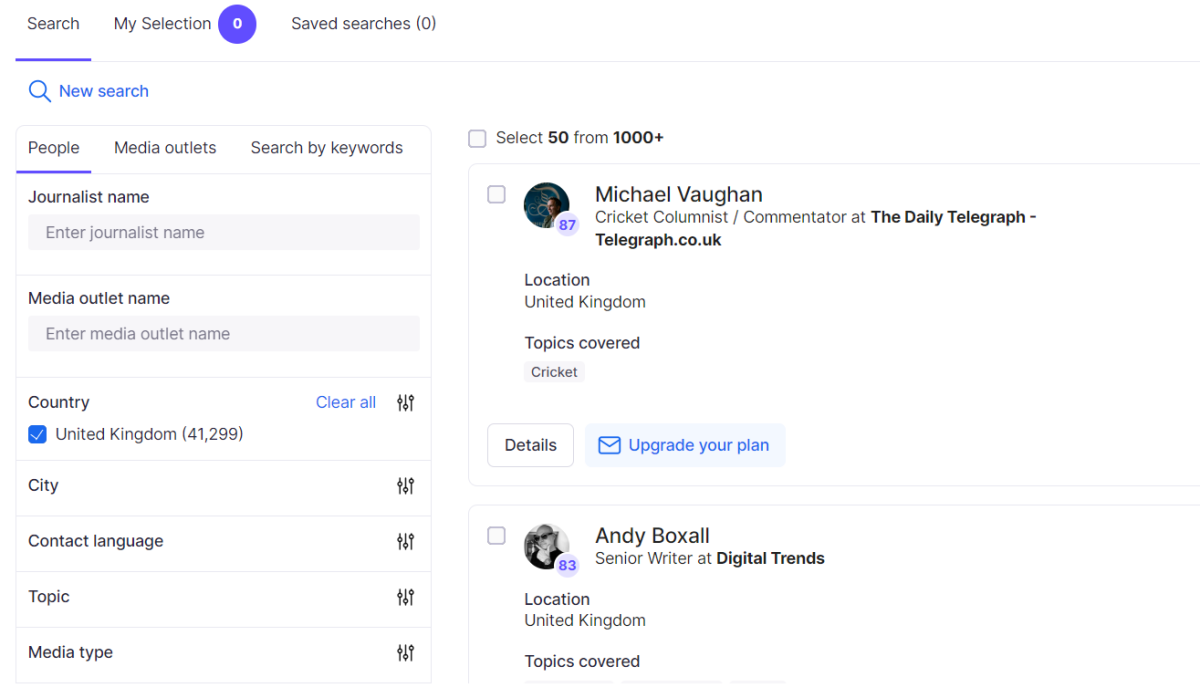
Here’s an example of how you can build out your search.

The tool then allows you to see the journalists’ contact information including their email address and social media profiles.
Whilst Prowly is a paid tool, it makes the prospecting process much easier as all of the relevant information that you’ll need is instantly available.
 Create Compelling Content: Once you’ve figured out who you’re going to reach out to, the next step is to create the content that you’ll use to get your brand recognized.
Create Compelling Content: Once you’ve figured out who you’re going to reach out to, the next step is to create the content that you’ll use to get your brand recognized.
When it comes to choosing a topic, ask yourself whether your target audience would share it – if the answer is no, it’s not compelling enough. Here are some types of content that you can consider creating:
For the client’s campaign, we focused on the unique selling point of their products – which was the fact that their tobacco-free, nicotine alternatives are made entirely from natural ingredients – which makes them a much healthier alternative to general cigarettes.
Here’s an example of a Digital PR piece that I did, where we surveyed 6,375 members of the public to find out which big tech companies they believed were having the biggest impact on society in the 21st century. This type of data-driven study is attention grabbing and provides the journalist with a unique story or topic that they are compelled to share.\
 Craft an Effective Outreach Pitch: once you’ve got your linkable content, you need to prepare your pitch to your prospective journalists.
Craft an Effective Outreach Pitch: once you’ve got your linkable content, you need to prepare your pitch to your prospective journalists.
Your pitch should:
Here’s an example template that you can use for your pitch:
Hello _____________,I hope this email finds you well. I’ve been following your work on [Publication Name] for some time now and have been impressed with the insightful articles and coverage you provide on [relevant topic/industry]. I wanted to reach out to you today with an exciting collaboration opportunity that I believe would be of great interest to your readers.At [Your Company/Organization Name], we recently conducted an in-depth study/developed a unique piece of content focused on [Brief Description of Your Content]. Our findings/insights are truly compelling and shed new light on [specific aspect/issue within the industry].
We believe this content would be an excellent fit for [Publication Name], as it aligns perfectly with your audience’s interests and the quality of content you consistently deliver. In addition to providing valuable information, we are confident it will generate significant engagement and discussion among your readers.
To give you a glimpse of the key highlights:
Point 1: [Highlight the most significant finding or insight]
Point 2: [Highlight another key finding or insight]
Point 3: [Highlight another key finding or insight]
We would be thrilled to offer you exclusive access to this content for an article or feature on [Publication Name]. We can provide you with all the necessary details, including visuals, data charts, and expert quotes to make your article comprehensive and engaging.
Furthermore, we would be more than happy to collaborate on any other content ideas you may have or contribute guest articles on related topics. We have a team of industry experts who can provide unique perspectives and insights to your readers.
In return for featuring our content, we would greatly appreciate it if you could include a link back to our website [Your Website URL] within the article. This will allow your readers to explore further and dive deeper into the research we’ve conducted.
Please let me know if this collaboration opportunity interests you, and if you would like more information or access to the full content. We are flexible and open to any suggestions or modifications to ensure a successful partnership.
Thank you for your time, and we look forward to the possibility of collaborating with [Publication Name] and providing your readers with valuable and engaging content.
Best regards,
[Your Name]
[Your Title/Position]
[Your Company/Organization Name]
[Your Email Address]
[Your Phone Number]
[Your Website URL]
 Monitor Your Progress: Once you’ve sent out your pitches to your media list, ensure that you keep tabs on which subject lines and email copy yield the best results in terms of responses and acceptance.
Monitor Your Progress: Once you’ve sent out your pitches to your media list, ensure that you keep tabs on which subject lines and email copy yield the best results in terms of responses and acceptance.
Here’s a list of some of the links that we landed:
Fixing Technical SEO Issues
The client’s website also had several technical issues that were preventing it from ranking to its potential. This included a poor URL structure and slow loading times.
Read on to learn how to tackle these for your own websites.
Implementing A User-friendly URL Structure
Before showing you how to structure your URLs, I’ll explain what a URL is and why it’s important for SEO.
What is A URL?
A URL (Uniform Resource Locator) is the address that specifies the location of a resource, such as a web page or a file, on the internet.
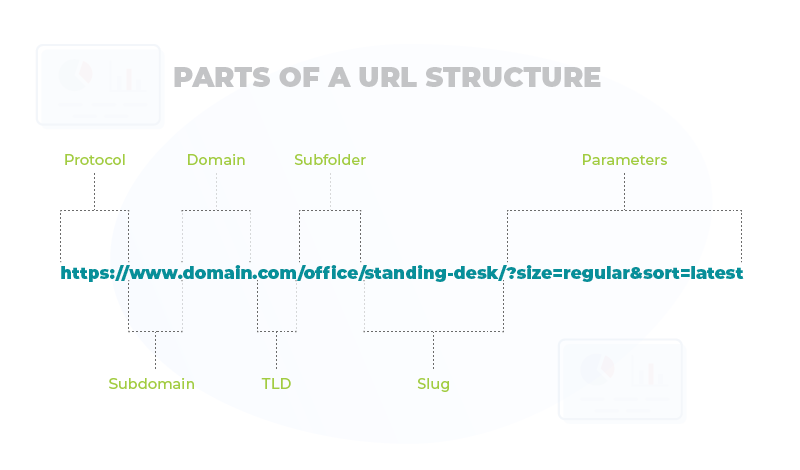
Why Are URLs Important for SEO?
In addition to other signals such as the page title, meta description and the content itself, Google also uses your web page’s URL to understand what your content is about.
In fact, URL structure is one of the factors included in Google’s SEO Starter Guide, which should be reason enough to highlight its importance.
Google displays the URL path as part of the search results, which means that searchers can use it to determine whether a page is worth clicking on.

In addition, if your URLs aren’t user-friendly not only will users not click through, but they’re also less likely to remember and share it.
Best Practices for Writing User-friendly URLs
Here are some tips on how to write URLs that are user-friendly:
 Keep URLs concise and meaningful: Ensure that your URLs are short and provide a clear indication of the content on the page.
Keep URLs concise and meaningful: Ensure that your URLs are short and provide a clear indication of the content on the page.
Pros
example.com/recipes/chocolate-cake/
Cons
example.com/recipes/the-best-ever-chocolate-cake-recipe-in-the-world/
Shorter URLs are recommended as they don’t get truncated in the SERPs and visitors are more likely to remember and share them.

 Optimize for a keyword: Include the main keyword that you want your page to rank for. This tells Google: “This page is about that keyword”. However, be cautious not to overstuff keywords, as it’s against Google’s guidelines.
Optimize for a keyword: Include the main keyword that you want your page to rank for. This tells Google: “This page is about that keyword”. However, be cautious not to overstuff keywords, as it’s against Google’s guidelines.
Pros
example.com/mens/socks/
Cons
example.com/mens-accessoies/mens-socks/
 Separate words with hyphens, not underscores: Use hyphens (-) to separate words in your URLs instead of underscores (_). Avoid joining words together too as it makes the URL more difficult to read for both search engines and users.
Separate words with hyphens, not underscores: Use hyphens (-) to separate words in your URLs instead of underscores (_). Avoid joining words together too as it makes the URL more difficult to read for both search engines and users.
Pros
example.com/recipes/chocolate-cake/
Cons
example.com/recipes/chocolate_cake/
example.com/recipes/chocolatecake/
 Use subfolders to create a logical hierarchy: Organize your URLs in a logical hierarchical structure that reflects your website’s content and navigation by using subfolders. This helps search engines understand the relationship between different pages on your site.
Use subfolders to create a logical hierarchy: Organize your URLs in a logical hierarchical structure that reflects your website’s content and navigation by using subfolders. This helps search engines understand the relationship between different pages on your site.
For example, if you have a recipe website, you may have subfolders for /desserts/. Which can be further organized into /cakes/, /puddings/, /cookies/ etc. So that you have URLs like:
Pros
example.com/recipes/desserts/cakes/
Cons
example.com/recipes/folder1/cakes/
Your individual recipes would then go into these subfolders, for example:
Pros
example.com/recipes/desserts/cakes/chocolate-cake/
Cons
example.com/recipes/folder1/cakes/chocolate-cake/
 Avoid adding unnecessary information: ensure that your URLs only contain the most relevant information about the page’s contents. This means avoiding adding things like the **** an article was published or using unnecessary words and phrases.
Avoid adding unnecessary information: ensure that your URLs only contain the most relevant information about the page’s contents. This means avoiding adding things like the **** an article was published or using unnecessary words and phrases.
Pros
example.com/blog/url-optimization/
Cons
example.com/blog/2023-05-12-url-optimization/
example.com/blog/how-to-optimize-your-urls-on-your-website/
 Avoid using unnecessary parameters: Minimize the use of query parameters and session IDs in your URLs, as they can make them appear cluttered and confusing to search engines. Clean URLs are more user-friendly and tend to rank better.
Avoid using unnecessary parameters: Minimize the use of query parameters and session IDs in your URLs, as they can make them appear cluttered and confusing to search engines. Clean URLs are more user-friendly and tend to rank better.
Pros
example.com/recipes/chocolate-cake/
Cons
example.com/recipes/chocolate-cake?id=360&sid=3aa6f849f730f1
 Use lowercase letters: Consistently use lowercase letters in your URLs to prevent any case sensitivity issues. Mixing uppercase and lowercase letters can lead to duplicate content and indexing problems.
Use lowercase letters: Consistently use lowercase letters in your URLs to prevent any case sensitivity issues. Mixing uppercase and lowercase letters can lead to duplicate content and indexing problems.
Pros
example.com/recipes/chocolate-cake/
Cons
example.com/recipes/Chocolate-cake/
example.com/recipes/Chocolate-Cake/
 Use HTTPS: Implement SSL encryption (HTTPS) on your website to ensure secure browsing for users. HTTPS is a lightweight ranking factor and helps build trust with your audience.
Use HTTPS: Implement SSL encryption (HTTPS) on your website to ensure secure browsing for users. HTTPS is a lightweight ranking factor and helps build trust with your audience.
Pros
https://example.com/recipes/chocolate-cake/
Cons
http://example.com/recipes/chocolate-cake/
 Choose a memorable domain: If you’re at the initial stages of building your website and haven’t yet selected a domain, prioritize choosing a domain that is easy to remember and has a strong branding potential as opposed to one that is keyword-rich.
Choose a memorable domain: If you’re at the initial stages of building your website and haven’t yet selected a domain, prioritize choosing a domain that is easy to remember and has a strong branding potential as opposed to one that is keyword-rich.
 Choose an appropriate TLD: If your website targets a specific location, choose a ccTLD (country-code top-level domain) such as .co.uk or .fr. For website’s targeting a global audience, choose a gTLD (generic top-level domain) like .com, .org.
Choose an appropriate TLD: If your website targets a specific location, choose a ccTLD (country-code top-level domain) such as .co.uk or .fr. For website’s targeting a global audience, choose a gTLD (generic top-level domain) like .com, .org.
These days there are hundreds of gTLDs to choose from that are extremely specific. For example, there’s a TLD for .guitars and .coupons.
Following the above guidelines will ensure that your URLs are not only user-friendly, but also search engine-friendly.
Improving Page Performance
It’s no secret that fast-loading pages provide a better user experience and therefore lead to higher user engagement, lower bounce rates, and increased conversion rates.
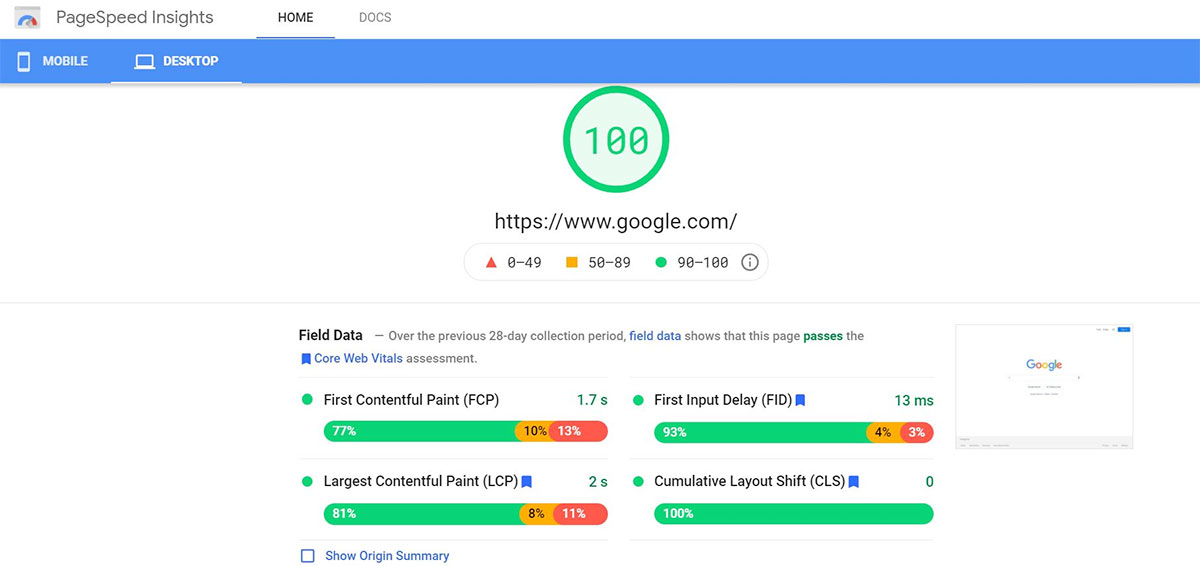
Search engines like Google prioritize websites that offer optimal user experiences, including fast-loading pages, so it’s important to ensure that you minimize the load times for resources on your website.
In the context of this case study, you’ll learn how to optimize the images on your website as well as improve the load times for other resources like JavaScript and CSS files.
Image Optimization
As an eCommerce business, it’s important that the images on the client’s website are of high quality so that they showcase the client’s products in the best possible light.
However, higher quality images are larger in size which lower the page performance of URLs, especially if there are multiple images that take a long time to load. Our client had hundreds of product images that were over 100 Kb in size.
Image Compression
Compressing your images helps reduce the file size without compromising too much on the quality. This in turn ensures your images are easier to load.
Below are a few free tools that you can use to compress your images:
Lazy-Loading Images
Lazy-loading is used to defer the loading of non-critical content (such as images or videos) until the user needs to interact with them.

This helps improve page load times and overall user experience by reducing unnecessary network requests and data transfer between the server and the web browser.
Lazy loading is especially useful for mobile users as it means that the server only needs to load and display the resources that are visible within the user’s viewport. In other words, if you’re viewing a web page on your smartphone, any images that are at the bottom of the page will be loaded if you physically scroll to the bottom.
Read on to find out how you can implement lazy-loading on your website with a super powerful plugin.
Minification
Apart from images, most websites will also have a lot of CSS stylesheets and JavaScript files that can take up precious time to process and load.
One way to minimize the load times for such files is to use minification.
Minification is the process of reducing the amount of unnecessary code in these files without addicting the actual functionality – this involves:
Here’s an example of some JavaScript code before minification:
function calculateTotal(price, quantity) {
var subtotal = price * quantity;
var tax = subtotal * 0.1;
var total = subtotal + tax;
return total;
}
And here’s what it could look like after minification:
function a(b,c){var d=b*c;var e=d*0.1;var f=d+e;return f;}
In this example, the minification process removes whitespace, renames variables, and shortens function and parameter names while preserving the functionality of the code. This results in a significantly reduced file size, optimizing the JavaScript code for faster delivery and execution.

There are a number of tools that you can use to do this (including ChatGPT, which is what I used to Minify the above code), for example there’s Terser for JS files and Totpal for CSS files.
However, a great tool that takes care of compression, lazy loading and minification, but also caters to improving other aspects of your website to boost page performance, I highly recommend installing (and investing in) NitroPack. That’s exactly what we did for this client.
The Results
Here’s what we’ve achieved by executing the above strategies in just over six months.
The organic traffic grew by 368% from 1,649 sessions to 7,720.
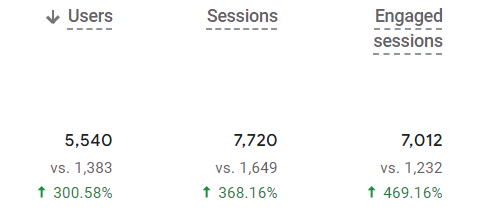
During this period, the monthly revenue increased by 445% from $2,908.85 to $15,873.88, with the client selling 5x more items.

The number of keywords that the site ranks for in the top 10 positions of Google increased from 12 keywords to 387 keywords – an increase of 3125%.
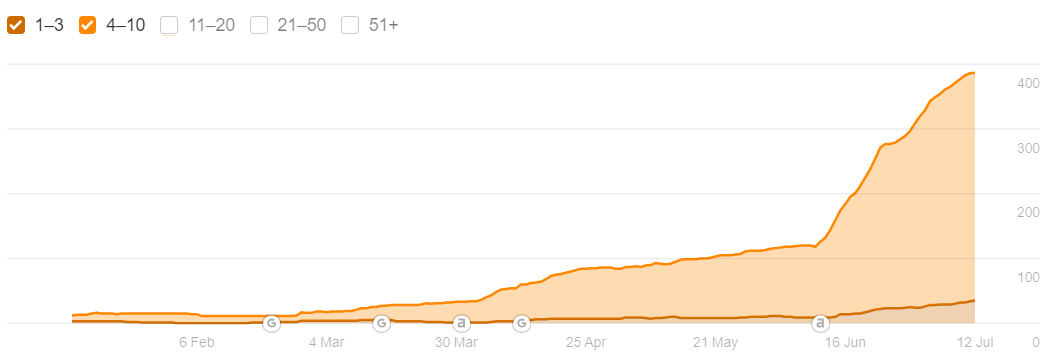
Overall keyword visibility within the top 100 positions grew by 1653% from 140 to 2,455 keywords.
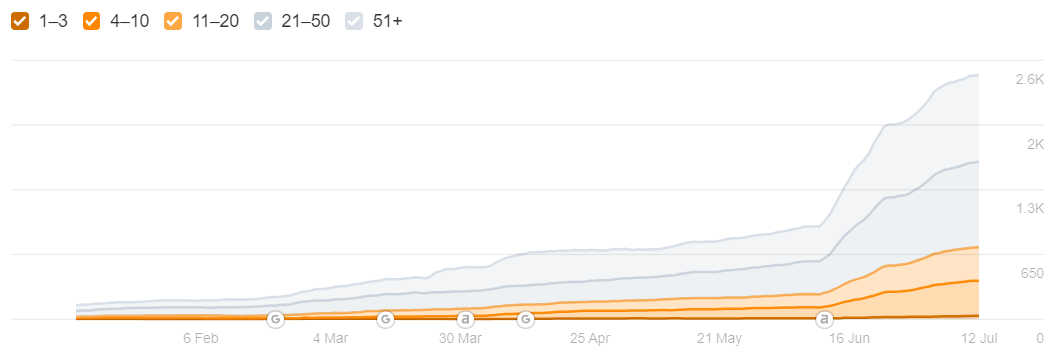
Conclusion
In this case study, I’ve shown you that even if the main keywords that you want to rank for are out of scope, there’s still a way to grow your site’s keyword visibility, as long as you choose the right keywords. Pair this careful keyword selection with an effective digital PR link building campaign, and you’ll be well on your way to boosting your site’s SEO performance.
In this case study, you’ve learned how to:
Implementing the strategy above will ensure that you build your site’s organic search presence through informational keyword targeting and blog optimization. You can also build your online reputation at the same time by providing a great user experience and showcasing your brand through digital PR link building tactics.
If you’re looking for help with your site’s SEO, get in touch with my team at The Search Initiative.




